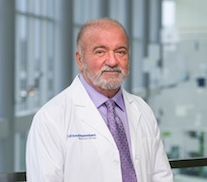Study: Optimal combination of chest compression frequency and depth for CPR identified

DALLAS – Aug. 16, 2019 – An international research consortium including UT Southwestern Emergency Medicine faculty was able to identify what is likely an optimal combination of chest compression frequency and depth when performing CPR.
The findings, presented in JAMA Cardiology, suggest the combination of 107 compressions per minute and a depth of 4.7 cm (about 2 inches) in the first five minutes of CPR can be associated with significantly improved outcomes when EMS rescuers are treating cardiac arrest outside the hospital.
In addition, the optimal combination identified did not seem to significantly vary when analyzed according to age, gender, presenting cardiac rhythm, or the use of a specialized device attached to the airway during CPR. Moreover, the investigators showed that the use of the device significantly improved outcomes when the target combination of rate and depth compressions was utilized.
The researchers found that even when CPR was performed within 20 percent of those chest compression values, neurologically intact survival was significantly higher -- 6% versus 4.3% outside that range. Considering an estimated 300,000 or more out-of-hospital cardiac arrests occur each year nationally, this could translate into thousands of additional lives being saved annually in the United States alone – and perhaps more if the target combination could be achieved routinely.
The premise for this work stemmed in large part from prior National Institutes of Health (NIH) studies including those led by UTSW faculty in which relatively-improved outcomes were observed when CPR was performed within a specified range of compression rates (100 to 120 per minute). Soon garnering the moniker the “Sweet Spot” of CPR, similar studies were also performed showing improved outcomes within a range of compression depth as well. But because variations in rate can affect the depth, and vice versa, the current investigators now sought to take the next step to identify the optimal combination of the two, a “sweeter spot”, to better guide rescuers in the future.

“The findings here not only emphasize the importance of quality CPR performance, but they will likely help paramedics and others on the frontlines now save many more lives,” said Dr. Paul Pepe, Professor of Emergency Medicine at UT Southwestern. “We knew that both the depth and frequency of chest compressions could each affect outcomes, but we still had yet to better identify the optimal combination of the two – and, perhaps more importantly, whether that optimal target would vary if you were a man or woman, or if you were older or had a longer period of cardiac arrest before rescuers reached you. This study provided critical new knowledge toward that end.”
Whether the findings would be universally applicable in all EMS systems has yet to be confirmed, but this study, conducted across 150 different EMS agencies in the U.S. and Canada, may be the best available findings to date. The researchers still advise that further validation of this target combination is recommended, especially when new devices, procedures or mechanical CPR tools are being introduced into the situation.
The study reviewed data from 2007-2009 from more than 3,600 patients who experienced cardiac arrest outside the hospital. Compression rate and depth were being recorded as part of a clinical trial conducted by the NIH Resuscitation Outcomes Consortium, for which UTSW served as one of the study sites on use of a specific CPR device called the impedance threshold device (ITD). It was the first multicenter trial to use electronically documented measurements of both chest compression rates and chest compression depth.
In addition to Dr. Pepe, the current optimal combination investigation was led by Dr. Sue Duval, Associate Professor of Medicine and Biostatistics at the University of Minnesota Medical School, assisted by an international team of resuscitation investigators based at the Medical College of Wisconsin, University of Oklahoma School of Community Medicine, the University Hospital of Grenoble Alps in France, and Toho University in Tokyo, Japan.
“What also makes this particular study especially important for the resuscitation research community was the novel way of presenting the data using a contour plot – a graphic presentation similar to a heat map – where the hottest points correspond to the best chance for neurological intact survival,” said Dr. Duval, the study’s principal investigator. “I believe this was another pivotal step in the continuum of research efforts to further save lives through robust data analysis.”
The Resuscitation Outcomes Consortium (ROC), supported by the National Institutes of Health and other federal and Canadian agencies, provided the key information for this study. The ROC has enrolled tens of thousands of patients in scientific evaluations of prehospital interventions to improve outcomes for severely ill or injured patients before they are transported to a hospital and it maintains a large registry of such cases.
Dr. Pepe, Riggs Family Chair in Emergency Medicine, also is Professor of Internal Medicine and Pediatrics at UT Southwestern, and EMS Medical Director for Dallas County.
About UT Southwestern Medical Center
UT Southwestern, one of the premier academic medical centers in the nation, integrates pioneering biomedical research with exceptional clinical care and education. The institution’s faculty has received six Nobel Prizes, and includes 22 members of the National Academy of Sciences, 17 members of the National Academy of Medicine, and 15 Howard Hughes Medical Institute Investigators. The full-time faculty of more than 2,500 is responsible for groundbreaking medical advances and is committed to translating science-driven research quickly to new clinical treatments. UT Southwestern physicians provide care in about 80 specialties to more than 105,000 hospitalized patients, nearly 370,000 emergency room cases, and oversee approximately 3 million outpatient visits a year.
